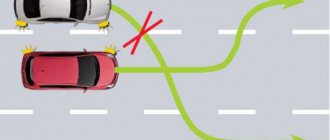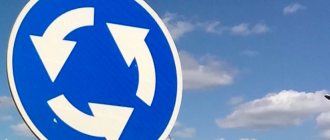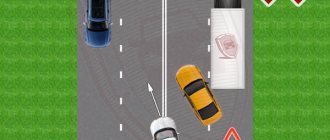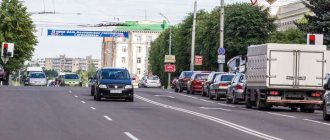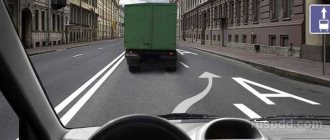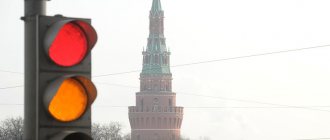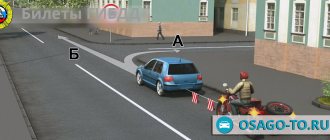On the road surface, the strip is additionally marked with the letter A. Areas for public transport stops are marked with yellow zigzag markings.
The rules allow not only public transport to use this lane.
Can move freely:
- Shuttle Buses;
school buses;
Drivers of regular vehicles are allowed to temporarily drive on a dedicated lane, but only in certain cases:
- When turning, requiring a right lane change.
- When entering the lane from an adjacent territory or a secondary road.
- For boarding or disembarking passengers.
At the same time, the driver should not interfere with route transport.
Sometimes dedicated lanes become accessible to any vehicle if information signs are added to the designation of the additional lane:
For motorcycles
Motorcyclists pose a serious threat to the safe movement of motorists: their risky driving style along markings and between rows often provokes.
At the same time, the movement of a motorcycle within the boundaries of road lanes is not regulated. The motorcyclist obeys the general rules.
It is prohibited for any type of vehicle to enter the marking lines, unless it is an authorized maneuver: detour, lane change.
In other cases, movement should be carried out only within the marked road lane. This rule applies to all vehicles, including motorcycles.
The traffic rules stipulate that moving vehicles must maintain distance and lateral spacing.
In theory, a motorcycle is not prohibited from moving between the rows:
- in the absence of markings on the road surface;
- if a lateral interval with neighboring cars is maintained.
To assess the safe interval, it is important to evaluate the dimensions of neighboring vehicles. If it is a heavy vehicle, the motorcyclist in the aisle is considered a violator.
It is strictly prohibited to move between the rows when there are markings.
Features of driving in the oncoming lane
Driving in the oncoming lane is undesirable, but in some circumstances it is possible and necessary. To avoid trouble in this dangerous area, you should:
- When turning and crossing roads, the car should not end up in oncoming traffic; this will be regarded as a violation, regardless of the number of lanes and type of markings.
- When overtaking is carried out on a two-way road with four or more lanes, passing in the oncoming lane is unacceptable.
- It is allowed to enter oncoming traffic if you need to perform one of the maneuvers: overtaking, turning around, going around an obstacle, turning left. In this case, the road should be three-lane, and its middle part should be intended for traffic in two directions.
- If the road is narrow and has no dividing markings, you can drive into the oncoming lane to overtake, provided there are no prohibiting signs nearby.
At the crossroads
There are special requirements for crossing intersections:
- If lane indicators are not installed and there are no markings on the roadway, when turning, you must stand in the appropriate lane. Those who plan to drive straight can choose any lane.
- If there are lane signs but no lane markings, you need to follow the signs and move according to where you need to go after the intersection.
- If there is a 1.8 dividing marking, you need to find your lane and move along it. Each row is marked with an arrow indicating permitted movement. If you can turn left, a U-turn is also allowed.
- In a situation where there are signs and markings at an intersection that have conflicting information, you should rely on the sign: it has priority.
When changing lanes
If you need to maneuver in lanes or before an intersection, you need to remember these rules:
- If a motorist was moving straight and intends to continue moving that way, the driver who wants to turn and therefore changes lanes is obliged to let him pass.
- In the event that drivers simultaneously intend to make a maneuver, the one who occupies the position on the right has priority.
For traffic safety, it is necessary to turn on the turn signal in advance, select the correct speed and do not forget about the mirrors.
These instructions apply to driving on any road, regardless of the presence of markings. It is worth remembering: if there are no dividing stripes, then the number of directions will always be even.
On a road with a reversible lane
There are no special signs indicating that there is a reversible lane on the roadway. There is a sign 5.8 indicating reverse traffic on the road, and a sign 5.10 indicating that there will soon be an intersection with a road with reverse traffic.
Reversing traffic lights also have nothing to do with lane designation. They regulate the movement of transport rows.
Reversing lanes are indicated by dividing markings 1.9. If there is one, there are, respectively, two stripes. If there are several markings on the canvas, then there will be as many reverse stripes as the number of stripes that have corresponding boundaries.
If the traffic light is not functioning or it simply does not exist, it is allowed to cross the reverse line if it is to the right of the driver. If there are reverse boundaries on both sides, you cannot enter such a lane.
What is allowed when starting a roundabout?
Based on traffic rules 8.5, you can enter the circle from any lane. There is one peculiarity in the roundabout: entry is allowed into the lane where the driver was before the start of the circle.
For example, it is prohibited to enter the left lane of a roundabout from the right lane of the roadway.
Driving in lanes when changing lanes
Changing from one lane to another before making a maneuver or crossing is a big challenge for some. After all, there is a danger of colliding with another car. In the traffic rules, lane movement and lane changes are regulated by clauses 8 and 9:
- If one car was driving and continues to move straight, and the second intends to turn, it is obliged to give way to the first. And only after that can it shift to the outer lane.
- Sometimes both cars are about to make a maneuver. This means that what is to the right of another vehicle has an advantage. First, this car is rebuilt, only after it the opponent performs the maneuver.
The rules apply regardless of whether the lanes are separated from each other by markings, or whether drivers have to determine them “by eye.” You just need to remember that without a dividing line, only an even number of them is possible (2, 4, but not 3).
More on AutoLex.Net:
Basic prohibitory traffic rules signs and fines for violation, coverage area of various signs
It’s more difficult when both cars are driving in the same lane and are about to change lanes at the same time. Here it is important to turn on the turn signal in time so that road users understand each other’s intentions, monitor the road with the help of mirrors and choose the right speed.
Watch this video on how to change lanes correctly:
Fines for violations
For traffic violations and when these violations are legally established by traffic police officers, drivers are subject to administrative liability:
| Violation | Amount of fine, rub. |
| Vehicle movement along the dividing strip (incorrect location of vehicles on the road) | 1500 |
| Crossing a “solid” road when entering a dividing strip | 500 |
| Changing lanes without warning signals | 500 |
| Turning from a lane prohibiting this maneuver | 1500 |
| Driving in oncoming traffic to avoid obstacles | 1000 – 1500 |
| Driving into oncoming traffic to overtake | 5000 |
| for 4 – 6 months. | |
| Deprivation of rights for 1 year if the offense is committed repeatedly | |
| If a repeated violation is detected by automatic means, the fine is 5000 | |
| Use of the bicycle lane by motor vehicles | 2000 |
| Driving in a dedicated lane | 1500 (for Moscow and St. Petersburg – 3000) |
| Violation of the traffic mode established for the lane | A fine similar to that for violating the speed limit |
Today, there are hundreds of different rules and regulations governing human activity in various aspects of life. Drivers of various vehicles are also required to comply with regulated laws. They are designed to ensure the safety of all participants in the process and create an optimal environment for them.
Among the many rules and laws, every driver needs to take into account a few of the most important ones.
Direction of traffic along the lanes, what does the traffic rules say? Watch the video:
They are presented below:
- The number of lanes
intended for driving in one direction; - What class does the road surface used belong to?
The driver can move around the city, outside it or in a populated area; - Two-way or one-way traffic
is installed on the road.
It seems that determining these parameters will not require much effort from the road user, but this is possible in the absence of external irritating factors. All kinds of precipitation can significantly impair visibility.
Roads with three lanes
In the event that a two-way road has 3 lanes, which are indicated by appropriate markings (with the exception of marking 1.9, indicating a lane allocated for reverse traffic), the middle lane is used for vehicle traffic in both directions, but with one significant limitation - to drive onto The middle lane is only allowed for overtaking, passing, and turning left (U-turn).
Example:
On such roads, driving a vehicle into the far left lane is strictly prohibited.
Example:
Driving in lanes
If there are several lanes in one direction outside populated areas, and in populated areas where the speed limit allows driving at a speed of more than 80 km/h, vehicles should move as close as possible to the right side of the roadway. If the right lane is free, the vehicle driver is prohibited from occupying the left lane, which can only be used for maneuvering.
Example:
In populated areas with normal speed limits, vehicles are allowed to use the lane that is most convenient for them.
Example:
Cases when vehicles can occupy the leftmost lane if there are three or more lanes in one direction:
- During heavy traffic, when all right lanes are occupied.
- For turning and turning. Example:
- For trucks with a permissible maximum weight of more than 2.5 tons - only for turning left and turning. Example:
Movement of slow-moving vehicles
A vehicle is called low-speed (regardless of the reasons for slow movement) if it moves at a speed of no more than 40 km/h.
Slow-moving vehicles must move only in the far right lane, entering the left lane only to bypass, overtake, change lanes before turning left (U-turn) or stopping, in permitted cases, on the left side of the road.
Traffic on tram tracks
Conditions under which trackless vehicles are allowed to travel on tram tracks:
- they must be in the same direction;
- located on the left and at the same level with the roadway;
- when all lanes in a given direction are occupied;
- when driving around, turning left (U-turn).
When a trackless vehicle moves along tram tracks, it should not interfere with the movement of the tram.
Example:
If road signs 5.15.1, 5.15.2 are installed in front of the intersection, movement on tram tracks through the intersection is prohibited.
If the roadway is divided into stripes by marking lines, vehicle movement should only be carried out along the designated lanes. In this case, driving over broken marking lines is only allowed when changing lanes. It is prohibited to move along the marking lines, as this may confuse other road users (they will assume that you are changing lanes), and it is also unsafe, because wet marking lines can be very slippery.
Driving on roads with reversible traffic
When entering a road with reverse traffic, the vehicle must move in such a way that when leaving the intersection of roadways, the vehicle occupies the far right lane.
Example:
Changing into the reversible lane is allowed only after the driver is convinced that driving in the reversible lane in this direction is permitted.
Driving on the side of the road
All vehicles are prohibited from driving along dividing strips, roadsides, sidewalks, and pedestrian paths (with the exception of cases of vehicles parking on the edge of the sidewalk, the movement of cyclists and horse-drawn vehicles, which will be discussed later).
Mechanical vehicles (except mopeds) are prohibited from driving on lanes for cyclists, bicycle paths and bicycle and pedestrian paths.
The movement of road maintenance and utility vehicles is allowed. Access is allowed along the shortest route for vehicles that deliver cargo to trade and other enterprises (facilities) that are located directly next to roadsides, sidewalks (pedestrian paths), if there are no other access options. At the same time, traffic safety must be ensured.
How to determine the number of lanes if the markings are not available
Road markings may not be visible to the driver. In this case, it is recommended to mentally divide the canvas into two identical parts and move along the right.
Band detection algorithm
- Divide the roadway into a pair of identical parts to distribute passing and oncoming vehicles;
- Divide the right side into lanes that allow cars to move freely;
- Drive in the chosen direction along an accessible part of the road.
How to determine how many lanes there are on a road. Photo: ds03.infourok.ru
The basic rule is that if there is a central road on the road that divides the highway in half, then it is forbidden to cross it, as this will complicate traffic in the oncoming lane and put all road users in danger. Maneuvers are also prohibited.
The minimum amount is five hundred rubles.
In this case, the driver did not cross a continuous line, but moved, moving between different parts of the highway.
If the driver made a turn or in the lane
, which only allows direct movement, you will need to pay a fine of one to one and a half thousand rubles.
If traffic rules were violated by a cargo vehicle
, then the fine will be five hundred rubles. In cities of federal significance, its volume has been increased to five thousand.
Contradictions between signs and markings
Sometimes drivers make the wrong decision due to conflicting signs and markings.
How to move along the lanes correctly so as not to get a fine? Tips from a driving instructor in this video:
- Detour into the oncoming traffic section of the roadway being repaired;
- when installing marking 1.1 and sign 3.21;
- Overtaking when setting markings 1.5 and sign 3.2.
Every year there is a tendency to tighten traffic regulations. This is a necessary measure.
Every road user is required to follow the described rules. Otherwise, this may lead to emergency situations on the road.
Setting the number of lanes if there are markings for all lanes
The most straightforward situation occurs when a separate lane on the roadway is marked with appropriate markings. For this purpose, one of three types of markings is used: 1.1 – delimits traffic flows of oncoming traffic and marks the edges of travel lanes on dangerous sections of roads; marks the boundaries of the roadway that are not allowed to be entered; marks the limit of areas for parking; 1.5 – delimits traffic flows of oncoming flows, including two or three lanes; marks the edges of travel lanes when there are two or more lanes that are designed to move with the same trajectory; 1.6 – signals the approach of markings 1.1 and 1.11, which separates traffic flows in opposite or identical directions.
Of the presented types of markings, only marking 1.1 is not allowed to be moved. In the above picture, counting the number of lanes on the roadway is quite simple - you simply need to count them.
How many lanes are there on a roadway without markings?
In circumstances where there are no markings and road signs on the road, it is possible to determine the number of lanes based on clause 9.1 of the traffic rules. It states that the number of travel lanes for vehicles that do not use rails for movement is established by markings and (or) signs 5.15.1, 5.15.2, 5.15.7, 5.15.8. If they are missing, drivers must independently determine the number of lanes, taking into account the width of the highway, the size of the vehicles and the proper distance between them. At the same time, the area calculated for the opposite movement on a road with traffic on both sides without a demarcation strip is taken to be half the width of the road, which is located on the left side, not taking into account local expansions of the roadway (transition-high-speed lanes, additional lanes on the rise, drive-in pockets of route vehicle stopping places).
There are fundamental aspects that need to be focused on: 1. Half the width of the vehicular part of the road, located on the left side, is considered the side designed for opposite traffic. 2. On their own half of the road part of the road, drivers have the right to personally determine the number of lanes.
A highway without signs and markings cannot be a three-lane road, even if the width of the roadway allows room for three cars. On such a road, the number of lanes is always a multiple of two, in other words, there are 2, 4, 6, etc., and not 3, 5, 7, etc. Regarding how to calculate the number of traffic lanes on your own half of the road, traffic rules does not regulate in any way. For this reason, the quantity can be determined as the driver deems necessary.
Traffic signs driving in lanes
Sometimes traffic rules signs make driving in lanes clearer and simpler, in other cases they make it more complicated. Problems arise more likely from those who do not know how to read them. What symbols can be used:
- 5.15.1. Indicates which of several lanes you can drive from it to the right, straight and to the left, from where you can turn around. The direction is easy to understand by the arrows.
- 5.15.2. There are several of these symbols. And each indicates one or two permitted directions. If the symbol is on the leftmost lane, it allows a turn in the same direction, under it you can change the trajectory by 180 degrees.
- 5.15.3. Shows the starting point of a new row for cars. The latter may be intended for braking or begin on an ascent. The symbol indicates an additional lane; traffic regulations require it to be used in different ways.
More on AutoLex.Net:
Service information road signs
If there is a speed limit on it, you cannot drive faster from here to the end of the coverage area. This usually happens in the braking zone. First they change lanes, only then reduce speed. If we are talking about an acceleration lane, they speed up the car on it, change lanes to the next one, not forgetting to let those who were already driving there pass.
- 5.15.4. It means the same as the previous symbol, but is installed where the central stripe begins (and there are two more on the sides).
- 5.15.5. Completes the acceleration section or climb.
- 5.15.6. It is installed where the central part of a three-lane road disappears.
- 5.15.7. Indicates which direction the movement is directed, and is necessary if there are more paths leading into one of them than towards them.
- 5.15.8. Shows the number of lanes and the speed limit for each.
The symbols may not be observed by public transport, but they are mandatory for everyone else.
Sequence for establishing the number of lanes.
To summarize the topic of determining the number of bands, we present an algorithm for determining their number. It will provide the opportunity to accurately determine the number of traffic lanes every time: 1. Find 5.15 signs on the highway. When they exist, it is necessary to determine the number of stripes based on them. 2. Find horizontal markings on the highway. Set the number of stripes using it. 3. Set the number of lanes individually, taking into account the fact that the left half of the roadway is used for opposite traffic.
Sanctions and fines for driving outside the lanes.
Now let's look at the fines that a driver receives for failure to comply with the rules of location on the roadway: 1. Article 12.16 on failure to comply with the instructions required by road signs or roadway markings states that for moving not along traffic lanes, but along the markings delimiting them, the driver is subject to punishment in in the form of a warning or a fine in the amount of five hundred rubles. 2. Article 12.20 on non-compliance with the rules for the use of external lighting devices, sound signals, hazard warning lights or warning triangles states that moving into the adjacent lane without using a turn signal entails a warning or the imposition of an administrative fine in the amount of five hundred rubles. 3. Entering a lane with oncoming traffic in order to avoid an obstacle is punishable by a fine in the amount of one thousand to one thousand five hundred rubles. For overtaking, the fine is five thousand rubles or the driver’s license is confiscated for a period of four to six months. If the offense is repeated, the driver's license will be revoked for one year.
After reading the presented publication, the reader will be able to easily and without problems determine the number of lanes on any highway, and his vehicle will invariably occupy a location on the roadway in accordance with the rules.
Often, many traffic violations and accidents are not the fault of drivers, but due to the narrow width or small number of lanes on the road. Thus, road signs or traffic lights are often obscured by branches or architecture, and because of potholes on the highway, motorists are forced to go around potholes and drive from one lane of the road to another.
You can also reduce your guilt or completely “amnesty” it if you drove into the oncoming lane while performing a maneuver, and the width of the lane itself turned out to be too small. Simply put, the road workers decided to save money and made a too narrow road instead of a wide one.
The Russian Federation has specially developed GOSTs and SNiPs (in particular SNiP 2.07.01-89, which clearly specifies the requirements for the geometric parameters of the roadway and individual traffic lanes.
The width of one lane depends on many parameters:
- where is the road - city, outside the city;
- maximum speed on a given route;
- number of lanes;
- the significance of the route is federal, republican, local.
Maximum bandwidth
in Russia it is
3.75 meters
. These are:
- high-speed highways (up to 130 km/h), with 4-8 lanes in both directions;
- main city streets, designed for speeds up to 100 km/h, 4-8 lanes.
GOST also states that the total width of such a highway (4 lanes in both directions) should be 15 meters. This does not take into account dividing structures and curbs. If we are talking about an 8-lane highway, the width of the roadway should be, accordingly, 30 meters.
Also, according to the same GOST, a width of 3.5 meters is allowed. This category includes:
- main roads with controlled traffic, designed for a speed limit of no more than 80 km/h, and consisting of 2-6 lanes in both directions;
- city roads, with controlled traffic, speed limits up to 80 km/h and a number of lanes from four to eight;
- transport and pedestrian roads of regional significance (with a curb for pedestrians), speed limit no more than 70 km/h, 2-4 lanes;
- streets and driveways leading to various transport, manufacturing or scientific enterprises where there is heavy traffic of trucks.
That is, on the central streets of cities where there are traffic lights and separate sidewalks for pedestrians, the width of one lane must be at least 3.5 meters.
Well, the narrowest roads are 3 meters wide. Although there is a special requirement that in case of repair work or due to the disgusting condition of the road, the width of the lane can be reduced to 2.75 meters.
Vehicle traffic on roads narrower than 2.75 meters is prohibited
. As a rule, these are various bicycle or pedestrian paths, special entrances and exits from adjacent areas for special equipment. This rule may not apply to transport of city utilities or to vehicles for delivering goods, and so on.
The following types of roads can have a width of 3 (2.75) meters:
- streets in residential areas;
- driveways in parks or industrial zones (not main, but auxiliary);
- secondary roads leading, for example, to remote urban settlements.
Oncoming traffic lane
The choice of lane is determined by signs, rules and depends on the direction in which the car needs to travel. There are many nuances here. But driving in oncoming traffic especially often raises questions among drivers. In some circumstances, visiting it is possible and necessary, but in most situations it can end in trouble. The oncoming traffic lane according to traffic regulations is used as follows:
- When turning, when the car passes the intersection of roadways, it should not end up in the oncoming traffic. Otherwise, it will be considered a violation regardless of the number of lanes and type of dividing lines.
- When overtaking on a two-way road, moving into oncoming traffic is also prohibited. This applies to areas with four or more lanes.
- You are allowed to go out onto it if you need to overtake, turn around, go to the left, or go around an obstacle. But the road must be three-lane, with markings (except 1.9). And its middle part is intended for driving in both directions.
More on AutoLex.Net:
What does the “Water Protection Zone” sign indicate, travel rules, installation according to GOST
- On a narrow road without dividing lines, you can drive onto it to overtake another vehicle. But there should be no signs prohibiting maneuver nearby.
In the last two cases, the driver will not break the rules. For ignoring the first and second points of the list, Part 4 of Article 12.15 of the Code of Administrative Offenses may be applied to him:
Driving, in violation of the Traffic Rules, onto a lane intended for oncoming traffic, or onto tram tracks in the opposite direction, except for the cases provided for in Part 3 of this article, shall entail the imposition of an administrative fine in the amount of five thousand rubles or deprivation of the right to drive vehicles for a period of four to four years. up to six months.
If the violation was committed in order to bypass a stationary object, use part 3 of the same article:
Driving, in violation of the Traffic Rules, onto a lane intended for oncoming traffic when going around an obstacle, or onto tram tracks in the opposite direction when going around an obstacle, shall entail the imposition of an administrative fine in the amount of one thousand to one thousand five hundred rubles.
